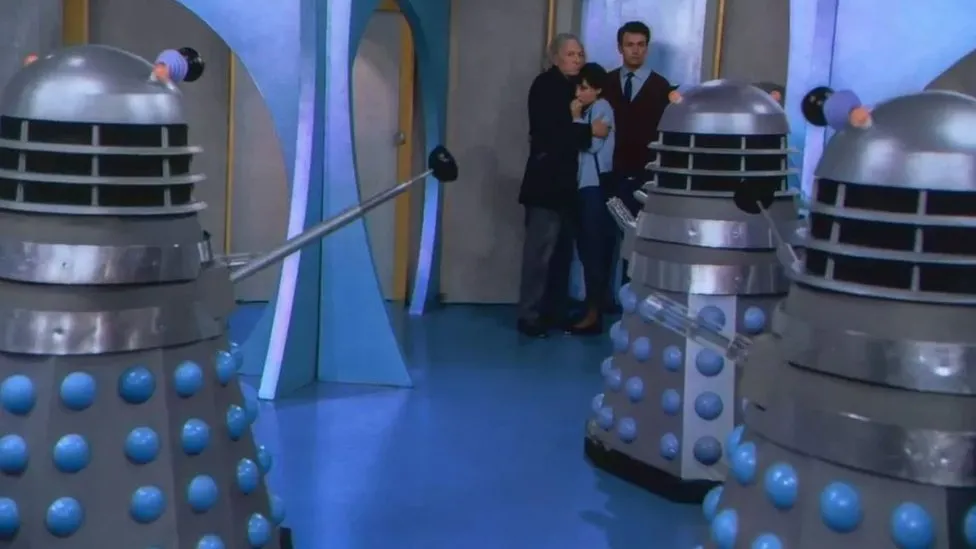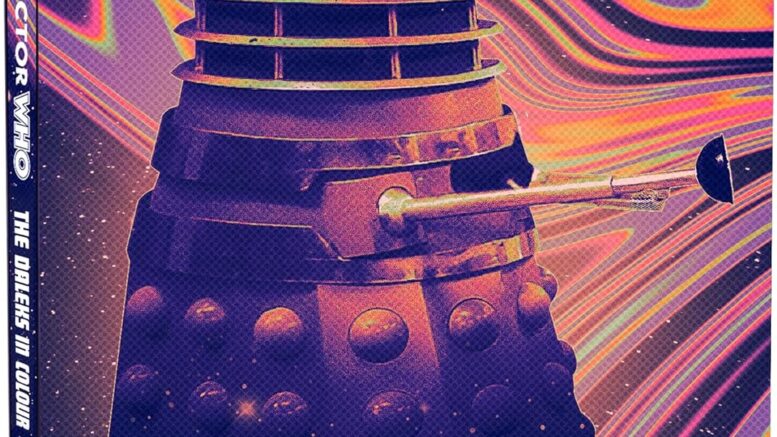
The Daleks – In Colour
Written by: Terry Nation
Directed by: Richard Martin
Colourization by: Rich Tipple
Edited by: Benjamin Cook
As part of the celebrations of sixty years of Doctor Who this year, the idea of The Daleks – In Colour was positively intoxicating.
It’s no real secret that after a shaky start, including a re-shoot, an inaugural episode dogged by real-life events (the assassination of President John F Kennedy), an unlikely re-broadcast and three episodes that were little more than “The Quest For Fire,” Doctor Who faced an uncertain, and potentially an unceremoniously short future when Terry Nation’s script for the story which, for the sake of argument, we’re calling The Daleks, went in front of cameras.
Between Nation’s rendering of a post-nuclear holocaust, racial extremism, and the folly of pure pacifism in the face of an implacable enemy, Ramond Cusick’s Dalek design, the vocal work of Peter Hawkins and David Graham, and a seven-episode script that gave the first Tardis team a chance to really show what they were capable of, The Daleks captured the hearts and minds of a nation that remembered (or still eulogized in play and comics) the horrors and the heroism of the Second World War, and were increasingly familiar with the devastating potential of the age of nuclear weapons.
The Daleks were that bottled-lightning thing – a weirdly charismatic alien menace that was both utterly devoid of humanity and yet showed us the worst of our own nature. They were an instant hit, and it’s probably no exaggeration to say they saved the show in its earliest days from the pressures of TV executives who wanted the experimental program killed.
Old Daleks For New?
So why, to celebrate the 60th anniversary – and the triumph – of the show, colourize that story?
Well, firstly, if you can, why wouldn’t you? Sixty years on, there’s an argument that black and white TV is so much a thing of yesterday that it alienates some younger fans and stops them enjoying the earliest eras of the show – so a colourized version could help draw in new audiences for what exists of those early stories.
Secondly, let’s not beat around the merchandising bush – if you can render old content “new” in some way, you get a new bite at the cherry of packaging it and selling it (the blu-ray and steelbook versions of The Daleks – In Colour are released in February!).
And thirdly, there’s the potential to help feed back into the modern show that colourization can bring (see an example of the colourized clips from The Celestial Toymaker used in the recent TV special, The Giggle).
So the question, when it comes to The Daleks – In Colour – is threefold. Does the original story still stand up? Does the colourization work? And does the edit work?
Three Hours of Daleks
First of all, let’s talk story. The Daleks is seven episodes long – at the time, the longest stretch of unbroken Doctor Who the audience had seen. It does, however, contain a lot of what would become very familiar Terry Nation Dalek script hallmarks – including a hangover from the era of cinematic adventure serials. That means you get at least a couple of quests that fill a whole episode while only advancing you probably one important story-beat, whether it’s Susan going back to the Tardis through the petrified jungle to find some anti-radiation drugs, or a schlepp through some unlikely-looking caves to launch a sneak attack on the Dalek city.
That can and occasionally does make The Daleks feel like harder work than it needs to be, particularly in an era where longer-form single-shot adventures are the order of the day.
In terms of the colourization, there have been quibbles in corners of the internet that, for instance, things that were black and white on broadcast have always “seemed” to be one colour, but were rendered in another (Barbara’s blouse being a particular case in point). But this is little more than the chuntering of the interminably unsatisfied, and as such should be comfortably ignored for the sake of our mental health.
Looked at with objective eyes, the colourization of The Daleks by Rich Tipple and his team is little short of mesmerising. It feels, often, somewhat surreal to remember that the original show was shot in black and white, because it makes it feel like what you’re watching shouldn’t, in some senses, exist – and yet there’s a fluency to the colourization that makes it an unparallelled treat.
There are colour palettes at work here which echo those that were eventually used when the Daleks hit the 1960s big screen in the two movies, Dr Who and the Daleks and Daleks’ Invasion Earth 2150 A.D, so there’s a sense of visual coherence to the colourization that helps you make the leap across the valley from what you’ve always known to this new and vibrant reality.
The Daleks Cut Down To Size
What is sadly less successful is the edit. In some respects, that’s a casualty of the sheer scale of the edit required. The Daleks on screen amounted to 175 minutes (a smidgen short of three hours in old money). The new edit clocks in at just 75 of those minutes, meaning it’s a whole episode less than half as long as the original.
With the best will in the world, you’ll struggle to deliver coherence with that much cutting to do.
And, in the interests of fair reporting, Benjamin Cook on editing duties absolutely struggles.
If you go in understanding quite how much has to be lost, it helps you take a breath before taking to the internet to spew a torrent of bile over the whole proceeding, and there are some useful pointers in The Daleks – In Colour to help future editors condense a long and fairly sprawling to-and-fro tale of jungles and caves and cities, (oh my!) into something that still tells the story coherently.
Voiceovers that help bridge the action gap can be useful, but if they’re overused, as they occasionally are here, they can end up reducing significantly the overall satisfaction the piece delivers.
And while Cook’s edit begins confidently – and competently – enough (getting rid of half an episode of aimless city wandering and getting us to the first episode cliffhanger by something like the six-minute mark), as the story rolls on and the sheer scale of the cutting that’s required to deliver a 75-minute version reveals itself, the cuts and leaps become more drastic, and give a viewer more and more severe storytelling whiplash. Imagine an improvised stage version of a three-hour movie, delivered by people who haven’t seen the original in a while, and who each have different ideas about what the story actually is, and you get the sensation that the edit of The Daleks – In Colour delivers.
Pointers For The Future
Add to that some new music by Mark Ayres, and what you get is an extra layer of tonal oddity. Ayres’ music itself is for the most part atmospheric (with perhaps one or two bizarre-sounding stylistic choices added in for good measure), but the uneven nature of the storytelling in the edit gives him little chance to deliver anything especially coherent, as the demands of the story, stripped of anything approaching filler or breath, can leave musical accompaniment an enormous challenge in the crunched-down version of the story.

Ultimately then, Rich Tipple’s colourization shines through The Daleks – In Colour as the unparallelled success of the experiment. What arrives on screen is powerful, engaging, and a thoroughgoing delight. And as a proof of the colourization concept for future releases, The Daleks – In Colour is a triumph.
What’s needed to make such future releases as successful as they could and should be is more coherent pacing in the edit. In fairness to Cook, for most stories, that wouldn’t be a problem. A 75 rendering of a four-episode story would mean cutting just an episode’s length out of the finished product.
Unfortunately of course, some of the black and white seasons of the show were crammed with exactly the kind of six or seven-episode epics of which The Daleks was a prime example. In the first season, for instance, only An Unearthly Child (and good luck getting the rights to colourize that any time soon) and The Edge of Destruction are less than six episodes long – two out of eight stories.
If there are going to be future colourized releases of some of those longer stories (Season 2’s six-episode The Dalek Invasion of Earth being perhaps the most obvious of choices), some greater leniency on the editor – in terms of both time and budget – might be necessary. Will that increase timescales and probably prices to consumers? Probably. Would it be a price more fans would be willing to may for more coherent edits? Equally probably.
Worth Your Money?
So is The Daleks – In Colour worth buying when it’s released?
For any completist, which includes many adult fans, absolutely, beyond a shadow of doubt. Simply by staring at the colourization, you get your money’s worth, because it feels like something new, and relatively unexpectable, is being delivered to you. As a proof of the colourization concept then, it’s a thing of unparallelled beauty.
As an exercise in storytelling, The Daleks – In Colour makes a brave stab at wrestling Terry Nation’s back-and-forthery to the ground and making it watchable in a single binge. But in trying to turn the seven episodes into just three, too much is unfortunately lost to make it a compelling imaginative experience.



Be the first to comment on "The Daleks – In Colour"